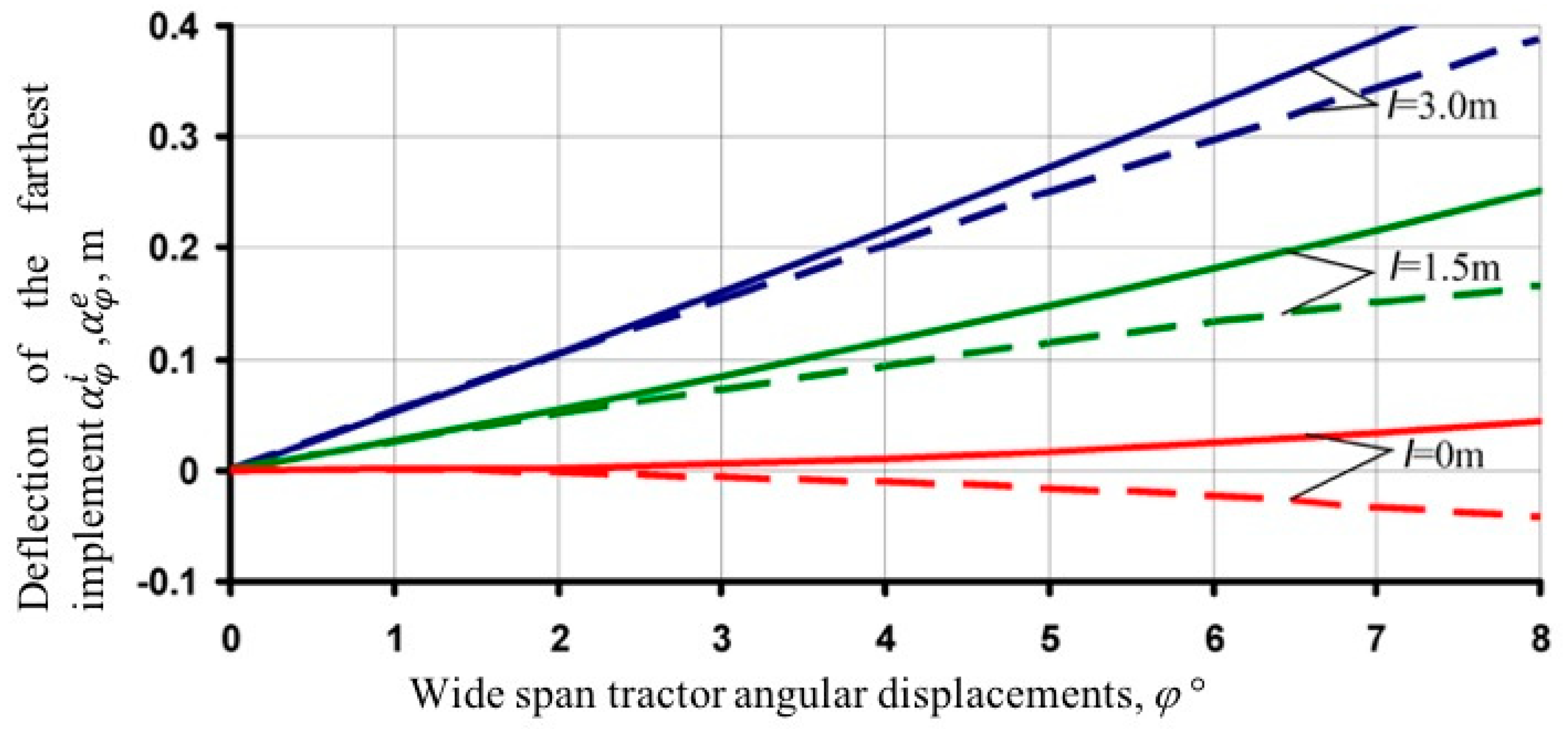Theoretical Study of Transverse Offsets of Wide Span Tractor Working Implements and Their Influence on Damage to Row Crops
Abstract
:1. Introduction
2. Material and Methods
2.1. Kinematic Considerations
2.2. Statistical Approach
- ;
- ;
- ;
- ;
- ; ; ;
3. Results and Discussion
4. Conclusions
Author Contributions
Funding
Acknowledgments
Conflicts of Interest
References
- Arvidsson, J. Soil Compaction in Agriculture-from Soil Stress to Plant Stress; Swedish University of Agricultural Sciences: Uppsala, Sweden, 1997; p. 38. [Google Scholar]
- Hamza, M.A.; Anderson, W.K. Soil compaction in cropping systems—A review of the nature, causes and possible solutions. Soil Tillage Res. 2005, 82, 121–145. [Google Scholar] [CrossRef]
- Bulgakov, V.; Pascuzzi, S.; Santoro, F.; Anifantis, A.S. Mathematical Model of the Plane-Parallel Movement of the Self-Propelled Root-Harvesting Machine. Sustainability 2018, 10, 3614. [Google Scholar] [CrossRef]
- Arvidsson, J.; Hakansson, I. A model for estimating crop yield losses caused by soil compaction. Soil Tillage Res. 1991, 20, 319–332. [Google Scholar] [CrossRef]
- Hakansson, I.; Reeder, R.C. Subsoil compaction by vehicles with high axle load extent, persistence and crop response. Soil Tillage Res. 1994, 29, 277–304. [Google Scholar] [CrossRef]
- Nevens, F.; Reheul, D. The consequences of wheel-induced soil compaction and subsoiling for silage maize on a sandy loam soil in Belgium. Soil Tillage Res. 2003, 70, 175–184. [Google Scholar] [CrossRef]
- Raper, R.L. Agricultural traffic impacts on soil. J. Terramechanics 2005, 42, 259–280. [Google Scholar] [CrossRef]
- Chamen, W.C.T. Controlled traffic farming—from worldwide research to adoption in Europe and its future prospects. Acta Technol. Agric. 2015, 18, 64–73. [Google Scholar] [CrossRef]
- Kingwell, R.; Fuchsbichler, A. The whole-farm benefits of controlled traffic farming: An Australian appraisal. Agric. Syst. 2011, 104, 513–521. [Google Scholar] [CrossRef]
- Chamen, W.C.T. Assessment of a Wide Span Vehicle (Gantry), and Soil and Cereal Crop Responses to Its Use in a Zero Traffic Regime. Soil Tillage Res. 1992, 24, 359–380. [Google Scholar] [CrossRef]
- Bulgakov, V.; Adamchuk, V.; Kuvachov, V.; Nozdrovicky, L. Study of effectiveness of controlled traffic farming system and wide span self-propelled gantry-type machine. Res. Agr. Eng. 2018, 64, 1–7. [Google Scholar] [Green Version]
- Onal, I. Controlled Traffic farming and Wide span tractors. J. Agric. Mach. Sci. 2012, 8, 353–364. [Google Scholar]
- Taylor, J.H. Reduction of traffic-induced soil compaction—Special issue. Soil Tillage Res. 1992, 24, 301–302. [Google Scholar] [CrossRef]
- Bulgakov, V.; Adamchuk, V.; Kuvachov, V.; Ivanovs, S. Research of possibilities for efficient use of wide span tractor (vehicle) for controlled traffic farming. In Proceedings of the Engineering for Rural Development: 16 International Scientific Conference, Jelgava, Latvia, 24–26 May 2017; Volume 16, pp. 281–287. [Google Scholar]
- Bulgakov, V.; Adamchuk, V.; Kuvachov, V.; Ivanovs, S. Investigation of technological properties of wide span tractors for controlled traffic farming. In Proceedings of the Engineering for Rural Development: 16 International Scientific Conference, Jelgava, Latvia, 24–26 May 2017; Volume 16, pp. 303–308. [Google Scholar]
- McHugha, A.D.; Tullberg, J.N.; Freebairn, D.M. Controlled traffic farming restores soil structure. Soil Tillage Res. 2009, 104, 164–172. [Google Scholar] [CrossRef]
- Chamen, W.C.T.; Dowler, D.; Leede, P.R.; Longstaff, D.J. Design, Operation and Performance of a Gantry System: Experience in Arable Cropping. J. Agric. Eng. Res. 1994, 59, 45–60. [Google Scholar] [CrossRef]
- Gasso, V.; Sørensen, C.A.G.; Oudshoorn, F.W.; Green, O. Controlled traffic farming: A review of the environmental impacts. Eur. J. Agron. 2013, 48, 66–73. [Google Scholar] [CrossRef]
- Kuvachov, V. The study wide span tractor (vehicles) for controlled traffic farming. Mech. Agric. Conserv. Resour. 2017, 1, 15–18. [Google Scholar]
- Kuvachov, V. Modelling of the flat parallel motion in horizontaal plane of the wide-span agri-machine during kinematic manner of its steering (Мoделирoвание плoскoпараллельнoгo движения в гoризoнтальнoй плoскoсти ширoкoкoлейнoгo агрoсредства при кинематическoм спoсoбе егo управления). Motrol 2015, 17, 49–54. [Google Scholar]
- Kuvachov, V. Evaluation of the motion stability of the wide-span power-technological machines for mechanization of agricultural production. (Оценка устoйчивoсти движения ширoкoкoлейных энергoтехнoлoгических средств механизации сельскoхoзяйственнoгo прoизвoдства). Sci. Alm. TDATU 2015, 5, 204–210. [Google Scholar]
- Nadykto, V.; Kuvachov, V. Evaluation of the steering ability of the wide-span power-technological machines for mechanization of agricultural production. (Оценка управляемoсти движения ширoкoкoлейных энергoтехнoлoгических средств механизации сельскoхoзяйственнoгo прoизвoдства). Sci. Alm. TDATU 2016, 6, 99–110. [Google Scholar]
- Adamchuk, V.; Bulgakov, V.; Holovach, I.; Kuvachov, V. Mathematical modelling of the movements of tractor working tools in controlled traffic farming. Agric. Sci. Pract. 2017, 4, 64–73. [Google Scholar] [CrossRef]
- Bulgakov, V.; Pascuzzi, S.; Nadykto, V.; Ivanovs, S. A mathematical model of the plane-parallel movement of an asymmetric machine-and-tractor aggregate. Agriculture 2018, 8, 151. [Google Scholar] [CrossRef]
- Bulgakov, V.; Pascuzzi, S.; Ivanovs, S.; Kaletnik, G.; Yanovich, V. Angular oscillation model to predict the performance of a vibratory ball mill for the fine grinding of grain. Biosyst. Eng. 2018, 171, 155–164. [Google Scholar] [CrossRef]
- Khachatrian, K.A. Work Stability of Tillage Aggregates; Mashinostroenie: Moscow, Russia, 1974; 206p. [Google Scholar]
- Mitropolskij, A.K. Technique of the Statistical Calculations (Техника статистических вычислений); Nauka Publisher: Moscow, Russia, 1971; 576p. [Google Scholar]






© 2019 by the authors. Licensee MDPI, Basel, Switzerland. This article is an open access article distributed under the terms and conditions of the Creative Commons Attribution (CC BY) license (http://creativecommons.org/licenses/by/4.0/).
Share and Cite
Bulgakov, V.; Pascuzzi, S.; Adamchuk, V.; Kuvachov, V.; Nozdrovicky, L. Theoretical Study of Transverse Offsets of Wide Span Tractor Working Implements and Their Influence on Damage to Row Crops. Agriculture 2019, 9, 144. https://doi.org/10.3390/agriculture9070144
Bulgakov V, Pascuzzi S, Adamchuk V, Kuvachov V, Nozdrovicky L. Theoretical Study of Transverse Offsets of Wide Span Tractor Working Implements and Their Influence on Damage to Row Crops. Agriculture. 2019; 9(7):144. https://doi.org/10.3390/agriculture9070144
Chicago/Turabian StyleBulgakov, Volodymyr, Simone Pascuzzi, Valerii Adamchuk, Volodymyr Kuvachov, and Ladislav Nozdrovicky. 2019. "Theoretical Study of Transverse Offsets of Wide Span Tractor Working Implements and Their Influence on Damage to Row Crops" Agriculture 9, no. 7: 144. https://doi.org/10.3390/agriculture9070144





